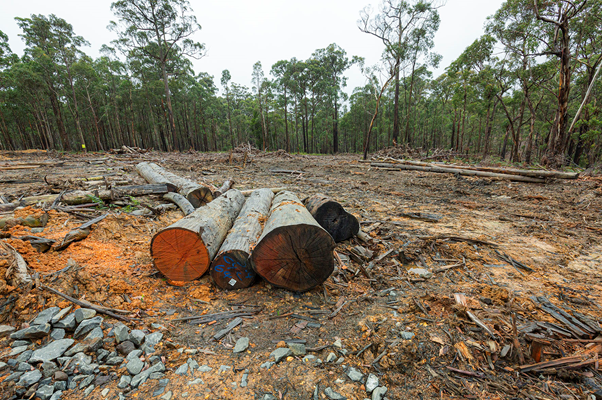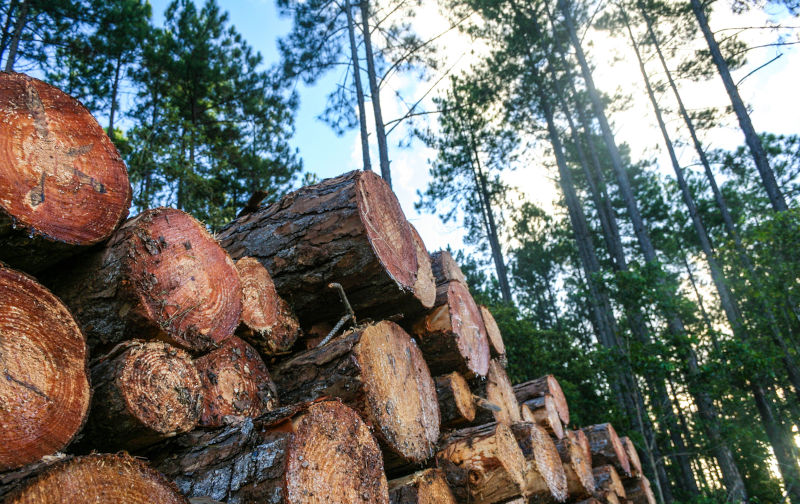Logging by another name – 'Forest Gardening'
September 6, 2024
First Nations’ sovereignty is in Country, and First Nations are sovereigns of their respective Countries. First Nations believe they have an obligation to defend Country from natural resource exploitation that causes widespread negative impacts to ecosystems. One of those forms of exploitation is native forest logging.
Although the Victorian Government announced it was halting native forest logging in January 2024, several kinds of logging are continuing in the state. One of these kinds of logging is known by another name: “Forest Gardening”.
Forest Gardening is occurring in the Wombat State Forest, west of Melbourne, in Victoria. Logging operations in the Wombat State Forest were introduced by Dja Dja Wurrung Clans Aboriginal Corporation (trading as DJAARA) as being subject to the principles of Forest Gardening. The term Forest Gardening is not a First Nations concept. Rather, the term and concept was first used by Robert Hart, an English horticulturalist (Whitefield 1996), but it is now being applied to what are to date industrial logging operations.
The term Forest Gardening entered the forestry lexicon in Victoria following widespread storms that damaged areas of the Wombat Forest in 2021. Following those storms, government logging company VicForests formed an arrangement with the Department of Energy, Environment and Climate Action to extract fallen trees (VicForests 2022b).
VicForests informed the DJAARA about its plans to extract logs from storm-impacted forests (Dawson 2022). VicForests then formed a partnership with DJAARA to log the Wombat Forest (VicForests 2022a). It was around this time that DJAARA announced its Forest Gardening strategy, stating it was “pleased to appoint VicForests to undertake making Country safe” in these post-storm logging operations. This was made clear in their media releases of both partners in the collaboration, when DJAARA stated that the logging operations were “being undertaken through the application of principles of Forest Gardening, and Country safe in removal of windthrown timber”.
A formal Forest Gardening and a contemporary Cultural Thinning strategy was launched on 13 December 2022. The strategy makes it clear that it will use western industrial practices, including what it termed “cultural thinning”. Notably, the head of the Victorian branch of Forestry Australia (formerly the Institute of Foresters) helped launch the Forest Gardening strategy (DJAARA and Wartaka 2022). The Forest Gardening strategy also had support from the CFMEU.
The logging operations in the Wombat Forest have used heavy machinery to cut down a large proportion of the trees in forest stands, skid the cut trees to log land landings, load cut trees onto trucks, and cart them to sawmills and firewood yards. The Forest Gardening conducted in 2022-2023 is virtually identical to conventional industrial logging operations previously practised in the Wombat Forest and elsewhere throughout Victoria (and across many other parts of south-eastern Australia).
The underlying rationale for Forest Gardening and Cultural Thinning in Australian forests is that they are “overgrown”. That is, there are too many trees and the understorey is too dense. In contrast, the pre-British invasion forest was open and park-like. While open and park-like conditions may be the case for some drier woodland environments, it is not correct for tall, wet forests or indeed many other types of vegetation, as eloquently discussed in the seminal book The Victorian Bush. If intensive (so-called cultural) thinning is applied in these wetter forest ecosystems, it will remove key habitat (such as understorey vegetation) for a wide range of species and hence have major negative impacts on forest biodiversity (Lindenmayer et al. 2009). It is also likely to generate large amounts of carbon emissions, (especially as most of the timber will be used as firewood, and pulpwood). These logging operations may also result in forests becoming more flammable, thereby adding to fire risks.
We are not saying that tall wet forests were “wilderness”. Absolutely not. First Peoples travelled through these forests and maintained pathways throughout them to access locations of importance to them. But these forests were used differently to other areas. It is essential that First Peoples reclaim Traditional Knowledge and seek to apply it. However, we contend that such Traditional practices would not involve Western forestry practices, which have historically been about intensive resource extraction, often with serious social, economic, and environmental costs. The Forest Gardening, as so far applied, is a “recent invention practice” and “black cladding”. It risks being yet another form of corporate exploitation; in this case, the native forest logging industry associating itself with First Peoples as a way to legitimise continued logging access to forests.
It is important to understand what is happening with Forest Gardening, especially since there are active plans to expand it in the Wombat Forest and elsewhere in Victoria. The proposed expansion of Forest Gardening includes upgrading a sawmill (Wuka 2022). For example, in October 2023, a business case report, authored by an international forestry industry consultancy, was submitted to the Victorian Government by the Dja Dja Wurrung Corporation for $14.47 million to expand Forest Gardening in the Wombat Forest (Wuka 2022). There have been proposals to commence Forest Gardening in other states such as Tasmania and New South Wales.
Many First Nations have identified ways to restore and manage their respective Countries through land rights, self-determination and Cultural practices. Industrial forestry has extensively degraded forests and endangered many species of animals. Continued logging will only make these problems worse. On this basis, we strongly believe there are better ways to assert sovereignty on Country than logging (even when it is misleadingly labelled Forest Gardening). First Nations people need to be on Country, to reclaim Custodianship and restore forests where they have been degraded by past exploitation, control feral animals, conduct fire management, and re-instate cultural and ecosystem resilience. These are more closely aligned with healing and looking after Country. Such Traditional Custodianship would enjoy much stronger public support than continued logging.

A log landing previously used for the collection of logs to transport for logging as part of the VicForests and DJAARA partnership which they termed “Forest Gardening”.
Dawson, M. 2022. Reimagining Forestry’s Strategic Collaborations & Partnerships. Presentation to the Forestry Australia 2022 Symposium.
DJAARA and Wartaka. 2022. Galk-galk Dhelkunya — Forest Gardening Strategy 2022 -2034. Dja Dja Wurrung Clans Aboriginal Corporation, Melbourne, Australia.
Lindenmayer, D. B., J. Wood, D. Michael, M. Crane, C. MacGregor, R. Montague-Drake, and L. McBurney. 2009. Are gullies best for biodiversity? An empirical examination of Australian wet forest types. Forest Ecology and Management 258:169-177.
VicForests. 2022a. Dja Dja Wurrung to work with VicForests to restore Country.
VicForests. 2022b. Storm timber recovery - VicForests project plan. VicForests, Melbourne, Victoria.
Whitefield, P. 1996. How To Make A Forest Garden. Permanent Publications, Hampshire, England.
Wuka, D. B. 2022. Business case: Forest Gardening in State Forest across Dja Dja Wurrung Country. Djaara Djaara Balaki Wuka, Melbourne.
